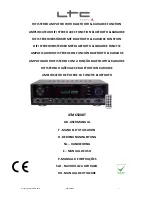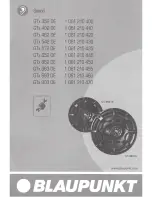
8 Subwoofers
SDDS Print Master Guidelines, Page
24
of
26
of its low pass filter, or even eliminate the synthesized signal altogether, depending on
the capabilities of the screen loudspeakers and the auditorium’s acoustical response.
8.10
Subwoofer polarity.
As a side note, it is often difficult to determine the correct polarity of the subwoofer,
digital or analogue. Even if pink noise is sent to the subwoofer and centre channels
simultaneously, in many cases there will be no apparent difference in combined wide
band SPL measurement when switching subwoofer polarity. I n the end the best
polarity may come down to an aesthetic judgement on the part of the cinema
technician, based on listening to actual films.
8.11
R ule-of-thumb methods.
Measuring the level of a subwoofer with a wide-band SPL meter is of questionable
value except as a rule-of-thumb method to re-check a theatre that has already been
properly calibrated. T he reasons for this include the fact that the measured acoustical
output of a subwoofer (or any loudspeaker system) depends on the bandwidth of the
signal ultimately being measured. T hat will be affected by the bandwidth of the input
test signal, any equalizer or low pass filter settings, the auditorium’s response, the
loudspeaker cabinet response, and the accuracy of the C weighting response at low
frequencies of the SPL meter used for the measurement. A subwoofer signal with a
wider bandwidth may measure the same as another with a narrower bandwidth but
higher level (as indicated by analyser bands within the pass band of the subwoofer),
using the same speaker cabinet. Considering the DFP-D3000, the bandwidth of the
pink noise sent to the subwoofer is affected by a low pass filter that can be adjusted
from 80Hz to 330Hz—a difference of three octaves or eight times in acoustical energy.
No standards exist for such wide band SPL measurements of subwoofers.
Although the measured SPL of wide band pink noise through the subwoofer will
change if the subwoofer’s low pass filter is adjusted, this will not change the actual
playback level of the digital LFE channel from film. So long as the filter frequency is
not set too low, the signals recorded on the dubbing stage will determine what is
heard in the cinema when the proper in-band gain difference is established
acoustically, as previously described. T his is why an engineer who uses a wide-band
SPL meter to set the digital subwoofer level is engaging in self-deception. I n general, a
low pass filter setting for the digital subwoofer (LFE) of 125 Hz, 160 Hz, or even
200 Hz should serve in most installations, and all settings should sound the same when
playing digital multichannel material. A low pass filter setting of 125 Hz will give a wide
band subwoofer SPL pink noise measurement of
approximately
91 dBc. T his rule-of-
thumb result is only approximate and should not be used for the primary alignment of
a theatre.



































